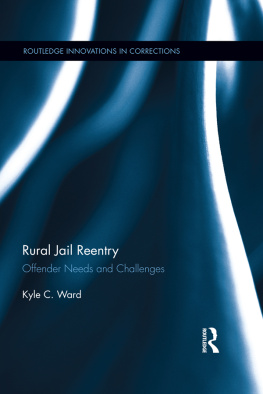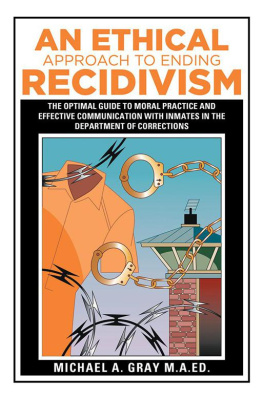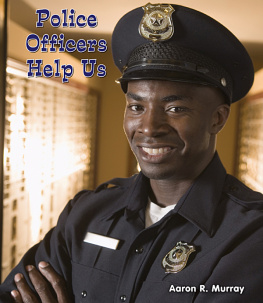Copyright 2014 by SAGE Publications, Inc.
All rights reserved. No part of this book may be reproduced or utilized in any form or by any means, electronic or mechanical, including photocopying, recording, or by any information storage and retrieval system, without permission in writing from the publisher.
Printed in the United States of America
Library of Congress Cataloging-in-Publication Data
Lutze, Faith E.
Professional lives of community corrections officers : the invisible side of reentry / Faith E. Lutze, Washington State University.
pages cm
Includes bibliographical references and index.
ISBN 978-1-4522-4226-2 (pbk.)
ISBN 978-1-4833-1161-6 (web pdf)
1. Parole officersUnited States. 2. Community-based correctionsUnited States. I. Title.
HV9470.L87 2014
364.6202473dc23 2013031692
This book is printed on acid-free paper.
13 14 15 16 17 10 9 8 7 6 5 4 3 2 1
FOR INFORMATION:
SAGE Publications, Inc.
2455 Teller Road
Thousand Oaks, California 91320
E-mail:
SAGE Publications Ltd.
1 Olivers Yard
55 City Road
London EC1Y 1SP
United Kingdom
SAGE Publications India Pvt. Ltd.
B 1/I 1 Mohan Cooperative Industrial Area
Mathura Road, New Delhi 110 044
India
SAGE Publications Asia-Pacific Pte. Ltd.
3 Church Street
#10-04 Samsung Hub
Singapore 049483
Acquisitions Editor: Jerry Westby
Editorial Assistant: MaryAnn Vail
Production Editor: Libby Larson
Copy Editor: Mark Bast
Typesetter: C&M Digitals (P) Ltd
Proofreader: Ellen Brink
Indexer: Maria Sosnowski
Cover Designer: Anupama Krishnan
Marketing Manager: Terra Schultz
PREFACE
Community Corrections Officers: The Invisible Side of Reentry
C ommunity corrections is a unique profession that possesses the coercive power of the criminal justice system to manage offenders risk and garners the power of the helping professions to address offenders needs. Parole officers, also known as community corrections officers (CCOs), reside at the nexus between prison and the community. Their work is multifaceted, involving offenders, the police, courts, prisons, social services, public health, education, labor, and the community. Their professional knowledge is extensive and is often used to bridge the gaps in offender management between the formal institutions tasked with managing offenders behavior and the informal systems of control and support provided by the community. Community corrections officers have the expertise to create a continuum of care for offenders that provides continuity across systems to effectively manage risk, reduce recidivism, achieve long-term reintegration, and enhance public safety. Due to their position strategically located at the end of the criminal justice process and in the community, community corrections officers are fully poised to orchestrate the successful reintegration of ex-offenders into the community.
Unfortunately, community corrections is rarely highlighted as an important resource to proactively achieve public safety. It is continuously viewed in the shadow of prisons, seen as less than law enforcement, and maligned for being too much like social work. In spite of the fact that community corrections is responsible for supervising the release of approximately 750,000 inmates from prison each year in the United States, a population that has grown 3.6 times that experienced in the 1980s, it remains a profession easily blamed by policymakers for the failures that should be attributed to the entire criminal justice system as well as other public institutions.
It is clear that many of the traditional approaches to reentry in an era resulting in mass incarceration have not been very successful. The likelihood of those released from prison to fail has remained stubbornly consistent over time with approximately 65% being returned to prison within 3 years after release and at least a third of these failing within the first 6 months. To address this failure, policymakers often turn to more of the same by designing tougher laws and investing more in prisons, police, and courts. When attention is paid to community corrections it is often in reaction to a rare, heinous event committed by an offender on supervision. These events often result in reactionary policies that further restrict the discretion of officers or serve to increase their responsibilities by enhancing their coercive control and power over offenders through such strategies as intensive supervision, electronic monitoring, and other intermediate sanctions. Even when reentry initiatives encompass more holistic approaches, the focus is often on addressing offenders needs or reorganizing systems to coordinate services across providers and not about directly investing in community corrections officers. Although providing for the needs of offenders and coordinating services are extremely worthy of investment, little consideration is given to whether community corrections officers have the support, resources, and expertise required to effectively manage the complex combination of risks and needs of offenders or the opportunity to collaborate with professionals in other agencies. Even when the need for systemic change is evident, either by managing risks or needs, CCOs are consistently asked to do more with less.
Regardless of what policymakers and correctional leaders do, CCOs have little choice but to deal with the reality of offenders lives and the importance of safely reintegrating them into the community to prevent future harm. To be successful they cannot afford to work in isolation because the risks and needs of offenders are too great to ignore. Thus, CCOs work across the criminal justice system by using the police, courts, jails, and prison to manage risk, problem-solve threats to community safety, and coordinate successful outcomes. To address the multiple needs of offenders they must engender the expertise and resources available through social services, public health, education, and labor to arrange the services necessary to address serious issues such as homelessness, mental illness, substance abuse, educational and skill deficits, unemployment, and a multitude of other stressors due to living in poverty. Their position, located in the community, allows them to create opportunities for offenders through building relationships with community stakeholders essential to offenders ability to develop prosocial relationships, become reunited with family and friends, obtain employment, establish a stable and safe place to live, and work toward long-term freedom from state control. It is clear that community corrections officers jobs are important to achieving the goals not just of corrections but of the entire criminal justice system.
This book brings the important work of community corrections officers out of the shadows of the prison and into the light of informed policymaking based on the reality of community corrections officers work and their importance to the success of the criminal justice system. I argue that community corrections officers are street-level boundary spanners who are in the best position to lead effective reentry initiatives built on interagency collaboration and a shared responsibility for reentry. In general, boundary spanners are people able to permeate the borders between diverse professions to create a mutual understanding of the others role and through shared communication, work to fill gaps in service, build trust, remove service barriers, and create the conditions necessary to achieve mutually beneficial outcomes. The criminal justice system alone cannot be solely responsible for assuring public safety when the risks and needs of offenders returning to the community from prison are so great. Therefore, community corrections power and utility are based in its ability to provide a fluid response to reentry inclusive of control, support, and treatmenta response led by community corrections officers.








